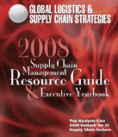
Visit Our Sponsors |
|
|
|
|
|
|
|
|
|
|
|
|
|
|
|
|
|
|
|
|
|
|
|
|
|
|
|
|
|
|
|
|
|
|
|
|
|
|

Analyst Insight
Although supply chain finance has been around for a long time (in different forms), in the past two years companies have taken a new look at this area. Pressed by the growing global competition to continuously reduce costs, companies are looking for yet another source of savings or profit growth - and supply chain finance has emerged as a new area to target to gain these improvements. Companies have begun to realize that finance costs embedded in the supply chain could be reduced by optimizing financial strategies with supply chain partners, finding new sources of pre- or post-export financing and implementing financial supply chain technologies. Some innovative firms have already revised the financial relationships with their buyers, suppliers, financiers and services or technology providers, which has allowed them to improve supply chain management processes and obtain better access to credit at various stages in the supply chain. New developments in supply chain finance, together with the supporting technologies, are helping market leaders to enhance global trade management and improve relationships with suppliers and customers worldwide
-Viktoriya Sadlovska, research analyst at Aberdeen Group
During 2006 and 2007, Aberdeen Group has benchmarked 750 companies on various topics in supply chain finance and working capital management. Based on this research, the ability to access financing at various stages in the supply chain has shown to be beneficial to a company's ability to optimize its supply chain. In a recent survey of 400 companies regarding their working capital optimization initiatives, participating companies that had the ability to access supply chain financing at various stages in the supply chain (payables/receivables/inventory financing) reported certain benefits, including:
• Almost twice as likely to have reduced their cash conversion cycle over the past two years
• 50 percent more likely to have improved their return on capital over the past two years
Best-in-Class companies in this study are 1.6 times as likely as Industry Average and 2.4 times as likely as Laggards to have the ability to access supply chain financing at various stages of their supply chains. Such access can be facilitated by the technology platform in place (e.g., an accounts receivables / accounts payable processing platform).
Another area where Best-in-Class companies have excelled is their adoption of a collaborative approach to supply chain finance. Best-in-Class are much more likely to collaborate both internally (across departments) and externally (with suppliers and customers) in establishing and managing their supply chain finance practices.
The Outlook
The Emerging SCF Market. Today, the innovators in supply chain finance techniques are beginning to look at end-to-end financial supply chain management more holistically and evaluate it not only in the context of their individual company but from a supply-chain-wide perspective. This strategic approach can lead to working capital improvements that have not been achieved before and ensure that a company establishes a long-term competitive advantage in the market. The supply chain finance market is now emerging: As corporations are redefining their approach, technology and services providers are searching for the optimal solutions that will best fit the market needs. Aberdeen Group expects noticeable developments in this market through 2010 both on the corporate and on the solution provider sides.
RELATED CONTENT
RELATED VIDEOS
Timely, incisive articles delivered directly to your inbox.

